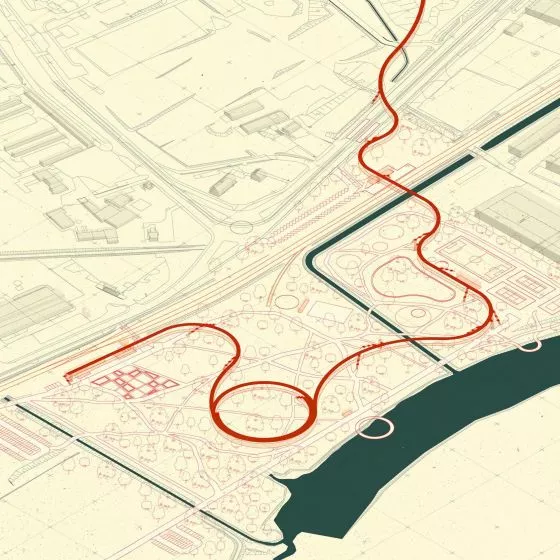The Museum and Cultural Center on Różana Street in Wilga is a project by Mikołaj Olszewski of the University of Arts in Poznań. The author touched on the problems of residents of the Poznan district and limited access to cultural offerings. His proposal points the way forward for the development of Wilda.
The center project was created as a desire to solve the problems of the Wilda district and improve the quality of life of its residents. Mikolaj Olszewski has made numerous historical and spatial analyses of this Poznan neighborhood, and conducted a search and survey of its residents. His project is an engineering thesis carried out under the supervision of Dr. Stanislaw Sipinski, UAP professor, and Stanislaw Lakinski.
Wilda Museum and Cultural Center
© Mikolaj Olszewski
Not only problems of Wilda
Lack of cultural institutions, inappropriate location of parking lots (public space has been taken over by cars, also the originally planted greenery and designed greenery have given way to them), limited access to recreational areas, smog - these are just some of the problems of Wilda. Mikolaj Olszewski's project is an attempt to solve them and is an indicator for the district's further development as a modern, green and youthful district.
The project is located on Różana Street in Poznan
© Mikolaj Olszewski
The problem of lack of cultural institutions in the area of Wilda appeared when the character of the district changed: from once industrial to now exclusively residential. The area under development does not have its own cultural center or museum facilities, which would be able to meet the needs of the current residents (the population of Wilda is about 60 thousand - CSO data 2018) [...]. The problem of developing the inner courtyards of development quarters, does not only apply to the developed area, but also exists throughout Poland and the world. Observing the current trends in architecture and the problems that contemporary design has to face, my project is one of the many responses to the aforementioned problems and is a continuation of the issues undertaken around the world," explains the author.
The building houses the frontage of Różana Street
© Mikolaj Olszewski
cultural center
Mikolaj Olszewski's work covers two plots of land on Różana Street in Poznan (one of which houses an fachwerkowy building). The author included revitalization of the existing building, made in half-timbered construction. Next to it he proposed a Museum and Cultural Center with underground parking. He also took into account the development of the roof, as a recreational space with a park function.
The author took into account the existing buildings in the project
© Mikolaj Olszewski
The main idea of my thesis was to create a place of culture, a kind of event center, for a full-fledged district of the city of Poznan, and at the same time to save the deteriorating architecture, which is a witness to the history of Wilda. The project was inspired by existing examples of public buildings with similar design issues and identical weather conditions (the need for thermal insulation of the building). The designed architecture was also influenced by the history of the district, the surrounding industrial buildings located in the Free Tracks area of Poznań, and the character of the current development of Upper Wilda - big-city tenements from the 19th century with characteristic detail and allure, often brick and richly ornamented, adds Mikołaj Olszewski.
project development scheme
© Mikolaj Olszewski
building within a building
Opposing the abandonment of historic buildings, Mikolaj decided to draw the existing buildings into the designed structure, thus creating a "building within a building," a kind of hybrid of history and modernity. He decided on this solution to close the frontage of the Rose Street development. The building was designed with residents in mind and its form open. The structure and functional-spatial solutions, have the hallmarks of universal architecture.
first floor of the designed building
© Mikolaj Olszewski
An important aspect for me became the concept of open buildings - Open Building78, which seems to be an answer to many contemporary challenges, including those related to the life cycle of buildings. The concept was developed by architect John Habraken. It involves an approach to design that recognizes the potential need to change or adapt a building to keep pace with ongoing social or technological change. Buildings of this type feature a sturdy and resilient structural frame with additional systems that allow for disassembly or reusability, such as elements of the facade, interior walls, furnishings and technical equipment. This reduces the consumption of natural resources and allows us to easily modify design schemes and plans," says Mikolaj Olszewski.
The architect used solid brick and aluminum, among other materials
© Mikolaj Olszewski
re life of buildings
The author opted for a skeletal, reinforced concrete, prefabricated structure and the use of high-end noble materials, such as solid brick, anodized aluminum and window ironwork elements. The spacing of the building's structural axes makes it easy to rearrange the museum and exhibition rooms into, for example, living quarters, offices, hospital rooms and other spaces that we cannot envision today. The height of the ceilings, staircases and adaptation of the building for the disabled, allow any arrangement of each floor.
Today it is a museum function, a public building, and what will it be like in 50 years? - wonders the author.











































































